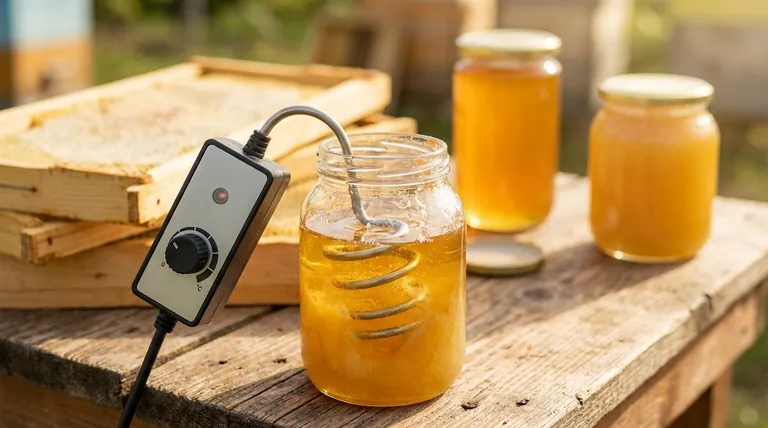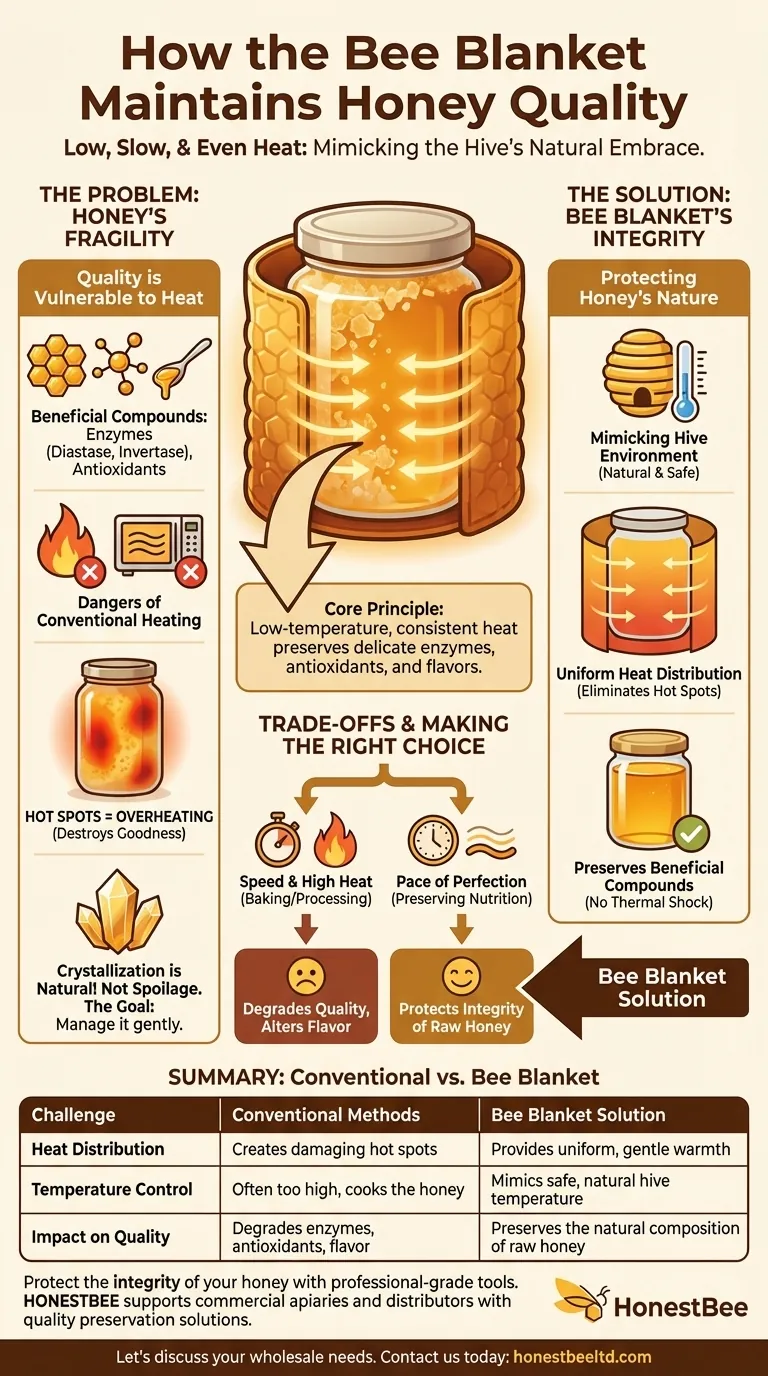At its core, the Bee Blanket maintains honey quality by using a gentle, consistent heating method designed to mimic the natural temperature inside a beehive. This low-and-slow approach softens crystallized honey back to its liquid state without "cooking" it, thereby preserving the delicate enzymes, antioxidants, and flavors that are easily destroyed by high or uneven heat.
The central challenge with crystallized honey is returning it to a liquid state without damaging its natural composition. The Bee Blanket solves this by applying uniform, low-temperature heat, safeguarding the very properties that define high-quality, raw honey.

The Problem: Why Honey Quality is So Fragile
To understand how the Bee Blanket works, we must first understand what makes honey vulnerable during the heating process.
What "Quality" Means in Honey
High-quality, raw honey is valued for its complex profile of beneficial compounds. These include enzymes like diastase and invertase, which aid digestion, and a wide array of antioxidants.
These components are extremely sensitive to heat. Aggressive heating methods fundamentally alter the honey's constitution, degrading its nutritional benefits and flavor.
The Dangers of Conventional Heating
Many common methods for liquefying honey, such as using a microwave or a hot water bath, are detrimental to its quality.
These approaches create "hot spots"—areas where the honey is overheated, even if the average temperature seems safe. This localized overheating is enough to destroy the beneficial enzymes and degrade the honey's natural goodness.
Crystallization is Natural, Not a Flaw
It's critical to recognize that honey crystallization is a natural process, not a sign of spoilage. It happens when glucose, one of the main sugars in honey, separates from the water.
The goal is never to prevent crystallization, but to manage it with a method that respects the honey's delicate structure.
How the Bee Blanket Protects Honey's Integrity
The Bee Blanket is engineered specifically to overcome the challenges of heating honey, focusing on two key principles: low temperature and even distribution.
Mimicking the Natural Hive Environment
The device operates at a temperature consistent with that of a living beehive. This is the environment in which honey is naturally created and stored.
By replicating this gentle warmth, the blanket ensures the honey is never exposed to temperatures that would compromise its integrity.
Ensuring Uniform Heat Distribution
The blanket's design provides even and consistent heat across the entire surface of the container.
This eliminates the dangerous hot spots that plague other methods. The entire volume of honey is gently and uniformly warmed, allowing the crystals to dissolve slowly without cooking any part of it.
Preserving Beneficial Compounds
This combination of low, even heat is the key to retaining the honey's natural benefits.
The antioxidants and enzymes are not subjected to thermal shock or degradation. The result is pure, liquid honey with the same freshness and constitution it had in the hive.
Considerations and Trade-offs
While effective, this method requires a different mindset compared to conventional heating. Understanding the trade-offs is key to appreciating its purpose.
The Pace of Perfection
The most significant trade-off is time versus quality. The Bee Blanket is intentionally slow.
This deliberate pace is necessary to gently liquefy the honey without causing damage. Faster methods will invariably sacrifice the quality you are trying to preserve.
It Preserves, It Doesn't Create
The Bee Blanket is designed to maintain the existing quality of your honey. It cannot add beneficial properties that were not there to begin with.
The final quality of your liquid honey will always depend on the quality of the crystallized honey you start with.
Making the Right Choice for Your Honey
Your approach to decrystallization should be dictated by your end goal.
- If your primary focus is preserving the full nutritional and enzymatic profile of raw honey: A low, slow, and even heating method is the only way to protect its integrity.
- If your primary focus is simply liquefying honey quickly for baking or processing: You must accept that faster, high-heat methods will degrade the honey's natural qualities and alter its flavor.
Ultimately, protecting honey's delicate nature requires choosing a method that prioritizes gentle, uniform warmth over speed.
Summary Table:
| Challenge | Conventional Methods | Bee Blanket Solution |
|---|---|---|
| Heat Distribution | Creates damaging hot spots | Provides uniform, gentle warmth |
| Temperature Control | Often too high, cooks the honey | Mimics safe, natural hive temperature |
| Impact on Quality | Degrades enzymes, antioxidants, flavor | Preserves the natural composition of raw honey |
Protect the integrity of your honey with the right equipment.
HONESTBEE supplies commercial apiaries and beekeeping equipment distributors with professional-grade tools designed for quality preservation. The Bee Blanket is a perfect example of our commitment to providing solutions that honor the delicate nature of your product.
Let's discuss how our wholesale-focused operations can support your business.
Contact our team today to learn more about our range of beekeeping supplies and equipment.
Visual Guide

Related Products
- Professional Thermostatic Conical Honey Melter
- Honey Concentrating Vacuum Heating Thickening Machine Dehumidifier for Honey
- 10L Stainless Steel Electric Honey Press Machine
- Electric 8 Frame Honey Spinner Extractor Equipment for Beekeeping
- HONESTBEE 72 Frame Industrial Electric Honey Extractor for Beekeeping
People Also Ask
- What is the effect of heating on honey? Preserve Quality with Controlled Warming
- What is melter honey used for? A Low-Cost Ingredient for Bakers and Brewers
- What are the negative effects of overheating honey? Preserve Your Honey's Natural Quality
- At what temperature does honey flow? Preserve Quality with the Perfect 95°F Sweet Spot
- How to permanently decrystallize honey? Embrace Its Natural State for Maximum Quality



















